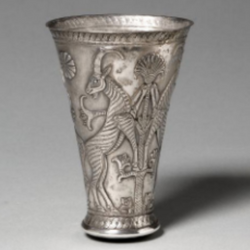
What is it?
The Flower of Life is a potent symbol of life force energy. It is one of the most well-recognized sacred geometry symbols. Found in locations around the world throughout history, the Flower of Life is a visual representation of the cycle of creation and the interconnectedness of life.

Many Symbols in One
Many symbols can be seen within the Flower of Life. It begins with a single circle, as seen in the diagram below starting from the left. Adding a second circle produces the vesca pieces. Some Christian traditions associate circles that compose the Seed of Life with the six days of creation, as described in the Book of Genesis. According to Genesis, in the first three days God created movement, light and the holy trinity. For some, these are represented by the first three circles. The Seed of Life, consists of seven circles of the same size and can be seen in the diagram below on the far right.
The Tree of Life, significant within the Kabbalah Jewish tradition, can also be found within the Flower of Life. The Sefirot as it is known, has 10 nodes presenting 10 channels of spiritual practice and divine life force. The Tree of Life is an ancient concept, tracing its roots to Assyria in the 9th century BC.

Following on from the tree and the flower of life, is the natural culmination of the cycle of life: the Fruit of Life.

Around the World, Throughout History
The Flower of Life is found around the world and so it’s impossible to trace its origin to a single culture or location.In Egypt in the Temple of Osiris (3000 BCE), the pattern may be found high up on columns. In Bejing China, the ball held by the Lion at the Gate of Supreme Harmony in the Forbidden City (1500 CE) shows a similar pattern.

This symbol depicted on drink ware is also an ancient concept, as show on this cup from 600 – 500 BC found in Crete, Greece.


Credit: Swedish Medelhavs Museum, Photo © Ove Kaneberg
What is the benefit of having the flower of life on the bottom of the glassware?
In its simple beauty and perfection, the Flower of Life is a symbol for the perpetual process of creation. It contributes to the harmonious revitalization of water.
Colours
Colours have an impact on humans arousing emotions and associations in nature design glassware the flower of life is available four colours. Select right colour for you intuitively based on the one which attracts you the most.
- Gold - The most popular choice, gold has been recognized throughout history for its allure and life force energy.
- Platinum - An extremely rare metal on earth, people who posses it should be proud. The deep silver grey platinum flower promotes confidence and self-love.
- Rainbow - The rainbow has a positive effect on us, emitting optimism and a positive attitude towards the world and ourselves.
- White - Known for its purity, white is associated with good, honesty, innocence and perfection. This flower will help you broaden your perception and be open to new opportunities.
Water held in products shaped according to the Golden Ratio and bearing the Flower of Life remembers the original code, the pattern of creation. This symbol, rich in history and significance, supports meditation. Focus your eyes on the symbol. Focus your thoughts intentionally on desired outcomes and draw on the power of this ancient symbol to guide your manifestation of good things to come.
References
All images Creative Commons copyright, unless referenced
